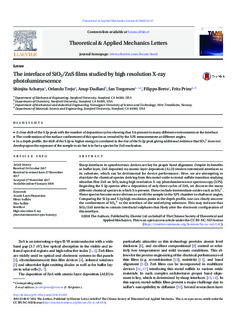| dc.contributor.author | Acharya, Shinjita | |
| dc.contributor.author | Trejo, Orlando | |
| dc.contributor.author | Dadlani, Anup | |
| dc.contributor.author | Torgersen, Jan | |
| dc.contributor.author | Berto, Filippo | |
| dc.contributor.author | Prinz, Fritz | |
| dc.date.accessioned | 2018-12-11T11:53:37Z | |
| dc.date.available | 2018-12-11T11:53:37Z | |
| dc.date.created | 2018-01-24T18:56:23Z | |
| dc.date.issued | 2018 | |
| dc.identifier.citation | Theoretical and applied fracture mechanics (Print). 2018, 8 (1), 24-27. | nb_NO |
| dc.identifier.issn | 0167-8442 | |
| dc.identifier.uri | http://hdl.handle.net/11250/2577111 | |
| dc.description.abstract | Sharp interfaces in optoelectronic devices are key for proper band alignment. Despite its benefits as buffer layer, ZnS deposited via atomic layer deposition (ALD) renders intermixed interfaces to its substrate, which can be detrimental for device performance. Here, we are attempting to elucidate the chemical species deriving from this metal-oxide to metal-sulfide transition studying ultrathin film ZnS on SiO2 using high resolution X-ray photoluminescence spectroscopy (XPS). Regarding the S 2p spectra after a deposition of only three cycles of ZnS, we discover the many different chemical species in which S is present. These include intermediate oxides such as SO42-. These species become more obvious as we tilt the sample in the XPS chamber to shallower angles. Comparing the Si 2p and S 2p high resolution peaks in the depth profile, one can clearly uncover the confinement of SO42- to the interface of the underlying substrate. This may indicate that SiO2/ZnS interfaces contain interfacial sulphates that likely alter the electronic configuration of this interface. | nb_NO |
| dc.language.iso | eng | nb_NO |
| dc.publisher | Elsevier | nb_NO |
| dc.rights | Attribution-NonCommercial-NoDerivatives 4.0 Internasjonal | * |
| dc.rights.uri | http://creativecommons.org/licenses/by-nc-nd/4.0/deed.no | * |
| dc.title | The interface of SiO2/ZnS films studied by high resolution X-ray photoluminescence | nb_NO |
| dc.title.alternative | The interface of SiO2/ZnS films studied by high resolution X-ray photoluminescence | nb_NO |
| dc.type | Journal article | nb_NO |
| dc.type | Peer reviewed | nb_NO |
| dc.description.version | publishedVersion | nb_NO |
| dc.source.pagenumber | 24-27 | nb_NO |
| dc.source.volume | 8 | nb_NO |
| dc.source.journal | Theoretical and applied fracture mechanics (Print) | nb_NO |
| dc.source.issue | 1 | nb_NO |
| dc.identifier.doi | 10.1016/j.taml.2018.01.008 | |
| dc.identifier.cristin | 1551332 | |
| dc.description.localcode | Copyright © 2018 The Authors. Published by Elsevier Ltd on behalf of The Chinese Society of Theoretical and Applied Mechanics. Published by Elsevier Ltd. This is an open access article under the CC BY-NC-ND license(http://creativecommons.org/licenses/by-nc-nd/4.0/) | nb_NO |
| cristin.unitcode | 194,64,92,0 | |
| cristin.unitname | Institutt for maskinteknikk og produksjon | |
| cristin.ispublished | true | |
| cristin.fulltext | original | |
| cristin.qualitycode | 1 | |

